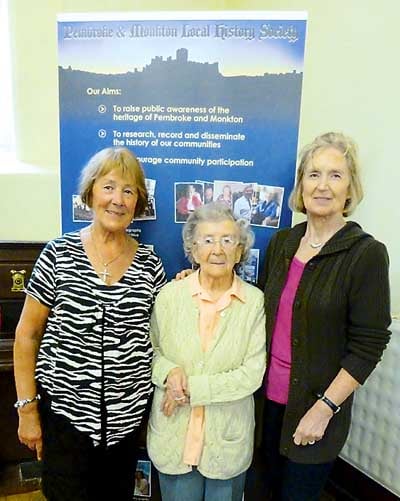I'm now back after a fortnight's break and I am indebted to Mickey Folland for sending me the entertaining stories of his Pembroke boyhood which have filled this page for the past couple of editions. Anyone else with stories from the past? I'd be pleased to hear from you!
Connections
I've spent the past couple of weeks across the Ocean in Nova Scotia, Canada. Far away from Pembroke, but whenever I go somewhere new I like to find connections, something of mutual interest.
To begin with, there are places which share our name and we decided to pay a visit to Pembroke, Nova Scotia. Not much there though - a few houses by the shoreline on Nova Scotia's Bay of Fundy, which lays claim to the highest tides in the world.
An interpretation panel informed us that every six hours the tides rise to an average of 50 feet: every 24 hours 115 billion tons of water move in and out of the Bay of Fundy, a volume equal to the discharge of all of the world's rivers. Some tide!
A short distance down the road, we stopped for lunch at a friendly pub which claimed fame for its hamburgers 'Home of the Walton Whopper: under one billion served' - they obviously like to think big around here!
What the Walton Whopper actually tasted like though I'm afraid I cannot say as we are both vegetarians. Good food anyway and lovely people - we left them with our Pembroke Sense of Place leaflet to promote old Pembroke back home!
Nova Scotia is an attractive province of Canada with settlements of colonial style houses spread around a pretty coastline of inlets and islands.
The lighthouse is an iconic image: there are so many of them. Nova Scotia's waters are treacherous, scene of around 5,000 recorded wrecks!
Its capital Halifax is an important port on the Atlantic and we were able to find much of interest: a visit to the Maritime Museum of the Atlantic was a must to find out more. The following information was gleaned from exhibitions at the Museum.
The first World Wide Web
We take communications for granted today: it is so easy to instantly message someone across the world However, until the mid 1800s you would have to have waited 40 days to recieve a letter from the other side of the ocean.
It was then that the introduction of the telegraph and undersea cables reduced this time to minutes.
The telegraph transformed the world in the way that the internet transformed communications in the late 20th century: Halifax and the cable ships that called it home played an essential role in this international communication network.
A local connection in transatlantic communication was the SS Great Eastern, which successfully laid the first transatlantic cable between Ireland and Newfoundland (earlier attempts had failed) in 1866.
The Great Eastern, one of Isambard Kingdom Brunel's great ships, first visited Neyland in 1860 for repairs. Later she was docked at Milford Haven from 1874 to 1886 when she was taken to Liverpool where she was broken up the following year.
The Titanic Connection
One hundred years ago the Titanic sank, a tragedy which stunned the world and even today creates interest and sympathy, inspriation of numerous books and films.
The effect was felt nowhere more than in Halifax, which dealt with the grim aftermath of the tragedy.
The day after the sinking, the White Star line chartered the Halifax-based cable ship Mackay-Bennett and soon after the CS Minia to embark on the task of recovering the bodies.
The cable ships and crews were very well suited for the task of recovering bodies. They had intimate knowledge of the area where Titianic sank, having spent years repairing cable in the North Atlantic. They knew the currents, weather and ice conditions, and the impact these factors would have on the dispersal of bodies and flotsam.
Following the sinking, the first ship to set out was the Mackay-Bennett under the command of Captain Lamder. It was loaded with 100 tons of block ice, 125 coffins, and an assortment of scrap and pig iron and old cable, the latter to be used for burials at sea.
In addition to her regular crew, undertaker John R Snow Jnr, undertaker-stonecutter George P. Snow, and Canon Kenneth C Hind of Anglican All Saints Cathedral were aboard when she sailed at midday on Wednesday, April 17.
They were met with a terrible sight "...as far as the eye could see, the ocean was strewn with wreckage and debris, with bodies bobbing up and down in the cold sea." Most of the bodies retrieved were found by the Mackay Bennett: 306 bodies, of which 116 were buried at sea and 119 returned to Halifax on April 30, where those, not returned to their families and countries of origin, now lie buried in cemeteries in Halifax.
Bits of debris and memorabilia are on show in the museum: a deck chair, parts of the décor, stories of survivors and of victims.
A visit to the cemeteries is moving: the Titanic graves are easily recognisable: small, square granite blocks on the whole, some named, some unknown.
There are a few monuments amongst them, one being that of the 'unknown child' whose body was one of the first to be recovered by the crew of the Mackay-Bennett.
Profoundly moved, the crew sponsored a memorial service for him and paid for his headstone.
However, recent DNA tests have now identified him as 19-month-old Sidney Goodwin who perished with his parents and five siblings. Perhaps one of the most poignant exhibits in the museum is a pair of brown shoes allegedly belonging to him.
If you are interested to know more, come along to our meeting on Friday, September 14, when Terry John will be giving his talk: 'Titanic: fact and fiction'.
A long haul
Halifax has encountered much tragedy and countless maritime disasters.
Today aeroplanes make for a safe transatlantic crossing. But while London to Halifax is no big deal, taking only five hours, the same cannot be said for London to Pembroke.
Eight hours in the coach and thoroughly exhausting. With a Welsh Assembly you would have thought that inter Wales travel would be a priority: unfortunately it goes from bad to worse.
Meanwhile, back in Pembroke
In my absence, the society has been busy and here I wish to thank Rachel Norman, our secretary, for holding the fort at our exhibition in the castle during the Jubilee celebrations and also for assembling our Jubilee exhibition in the window of the now empty shop 'Pretty Woman'.
In this she was assisted by Trudy Lisle, of 'Dragon Alley', and her daughter Jess, and also Laura John. Many thanks to Hilton, Glenys and Steve Brown for allowing us to use the window.
Also, whilst I was away, we have received two awards for our efforts in promoting the history of Pembroke: first by Pembroke Town Council and second by PAVS for 'the outstanding work made to the community through volunteering'. Nice one!





Comments
This article has no comments yet. Be the first to leave a comment.